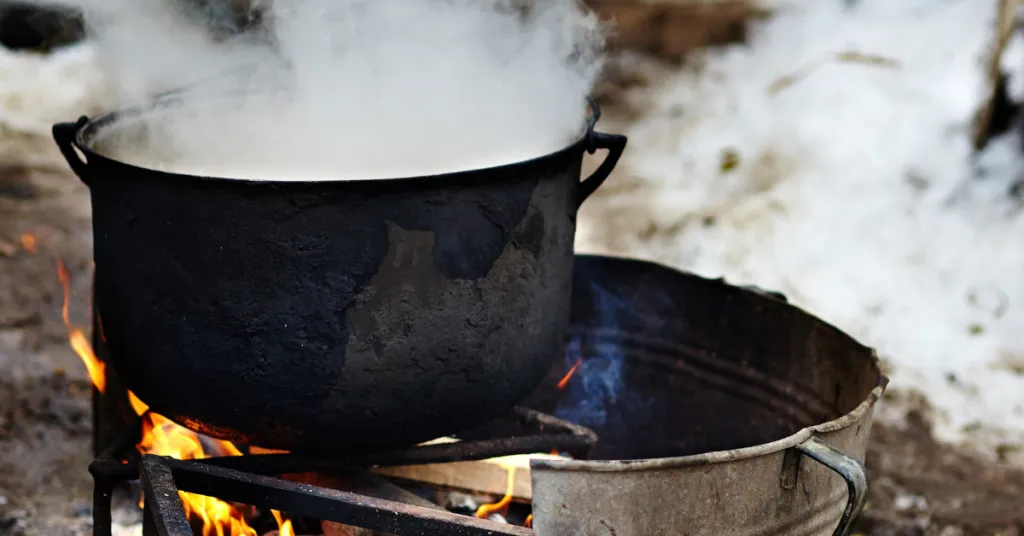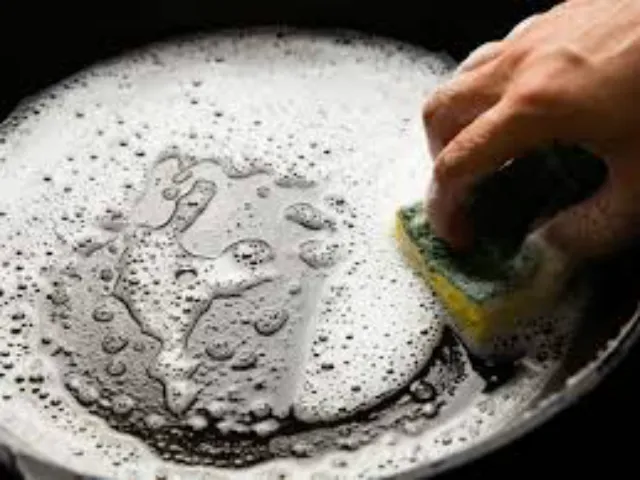It is natural for iron to rust, and yes, cast iron rusts, too.

Rust forms on iron and cast iron when it is exposed to humidity or moisture and a lack of seasoning to protect it.
But can you fix a rusty
No, please don’t throw it away because there are solutions. All is not lost because of a little bit of rust.
With the right knowledge and tools, you can fix it, and we will tell you how!
Table of Contents
Rust On Cast Iron
Cast iron cookware is not like any other type of cookware. It’s unique, and it demands extra care in seasoning and maintenance to protect it from rusting.
Whether you’ve acquired a piece of cast iron from your parents or grandparents, purchased one yourself, or by some other means, most likely, you have had the surprising reality that cast iron rusts.
Identify The Severity Of Rust
But suppose rust does happen, and it will. In that case, the very first step in fixing the problem is to assess the severity of the rust that has formed on the cast iron to determine what actions need to be taken.
Rust is usually a minor issue, but if left untreated for extended periods, it can become a major issue, eat into your cast iron, and cause irreparable damage called pitting.
Even if there is pitting, don’t lose hope. Your cast iron can still be used after proper cleaning and rust removal.
Minor rust, or light surface rust, is what we might call “flash rust.” Flash rust occurs almost immediately after washing cast iron in hot water or by being exposed to moisture due to the lack of a protective coating called “seasoning.”
*Pro Tip* Cold water, for whatever reason, doesn’t cause flash rust to form as quickly and as severely as hot water does.
So, after determining whether the rust is minor or more extensive, there are methods to alleviate the frustrations of rusty cast iron.
How To Remove Rust From Cast Iron
After assessing the type of rust that formed on your cast iron, the next step is to safely and effectively remove it.
The process to achieve that can range from a simple solution like using a Lodge Rust Eraser to a more aggressive technique like electrolysis.
Electrolysis is generally reserved for the more experienced persons in cast iron restorations.
Before we dive into the methods I recommend, I must also share with you what I personally do not recommend.
I don’t recommend using steel wool. I know some who use steel wool and would argue against my point. Still, I do not want to take any chances with the fine pieces of steel wire getting lodged somehow in my cast iron and, possibly, into my food.
Another method some suggest is using an electric grinder or wire wheel to remove rust.
However, these techniques can be risky as they can potentially damage the surface of the skillet, although they are better than steel wool.
Therefore, I do not recommend these two methods for removing rust from your
The Lodge Rust Eraser
For surface or flash rust, I recommend a few easy solutions. One is The Lodge Rust Eraser, a specially designed tool for removing minor rust from cast iron.
It is convenient to have one of these erasers because it can remove very minor rust with surprising ease and without damaging the seasoning or the surface of the skillet.
Salt And Oil
Another trick is an oil and salt paste. Together, these two form a fairly non-abrasive cleaner that removes rust by simply wiping it around all over the rusty area and then rinsing it clean.
The salt helps rub the rust away, while the oil helps maintain the finish or seasoning of the pan. So, I would use salt to clean and prevent rust in the future.
Vinegar Rust Removal
Next up is vinegar, which is known to be an excellent cleaning solution.
Vinegar is very acidic, though, and can actually damage cast iron if left soaking for extended periods. But, when used correctly, it can safely and effectively remove rust.
My suggestion for the proper solution would be to dilute the vinegar with water to a 1:1 ratio. You can use this method by adding it to a spray bottle, spraying a fine mist over the rust, and letting it set for a few minutes.
You should check to see what is happening about every 10-15 minutes. If the rust is dissolving, rinse it with cold water and dry it thoroughly.
For a more extensive rusty
For heavy, rusty cast iron, I have let it soak in undiluted vinegar overnight with no problems at all.
I wouldn’t let it soak longer than overnight without inspecting the cast iron first.
As I said earlier, vinegar is very acidic, and it can begin to eat into the cast iron when exposed for extended periods.
After rinsing with cold water, the key to preventing rust from reappearing is to thoroughly dry the cast iron and then apply a thin coat of seasoning oil.
Cast Iron Electrolysis
The last solution is cast iron electrolysis. Electrolysis is super effective at removing any and all rust from cast iron, but it can also be dangerous if you don’t know what you are doing.
The main reason it can be dangerous is because it involves using water and electricity.
I recommend that this method be left only to the more experienced due to the hazards involved.
How To Re-Season A Cast Iron Skillet
Once all of the rust has been removed, the last step to fix a rusty
This is to protect it from rust and prevent it from reappearing.
The process of seasoning a
Traditionally, though, it is achieved through the following three steps.
Step One
The very first step is to make sure it is clean and dry.
Step Two
The next step is to coat the entire skillet with a thin layer of oil. This is the most crucial step in seasoning cast iron, and attention needs to be given because too much oil, once baked, will become sticky and gummy. We don’t want sticky cast iron!
I use Crisco or avocado oil to coat the entire surface of the skillet, including the handle and bottom. The whole skillet must be well-oiled since it’s entirely made of cast iron.
These are not the only oils that can be used, but they are two of my favorites.
After applying oil, use a soft cloth, towel, or cotton t-shirt to wipe off all the excess oil.
Although it may seem counterintuitive to wipe it all off, this step is essential for achieving a successful base coat of seasoning every time.
Step Three
The final step is to place the
Once cool, an additional layer or two can be baked on to help establish a non-stick surface to protect the cast iron against any future rust.



